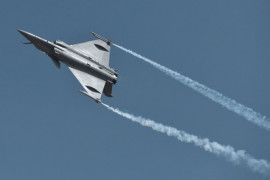
As expected, the Punjab budget for 2012-13 is a tit for tat response to the fiscal profligacy of the federal government. Like the federal budget, its emphasis is on expenditure to maximise electoral returns. Government employees are to receive a 20 per cent increase in pays and pensions. Some 300,000 temporary or permanent jobs have been promised through interest-free loans, internships for graduates, filling of vacancies, new recruitment in the police and education departments and various technical and vocational training schemes have also been promised. The federally announced minimum wage for industrial workers has been topped up by Rs1,000 to Rs9,000. Rural palliatives include the five-marla plots for the homeless, 12.5 acres of state land for the landless and the extension of the katchi abadi law. Pet urban programmes like the Danish Schools, women and IT universities, Ashiana Housing Scheme and model bazaars continue with larger expenditure and coverage being allocated for them. More projects can be added as Rs40 billion, or 16 per cent of the development budget, is kept in the handy category of miscellany. This head actually consumes the entire ‘record’ increase over last year’s development programme. Cheap flour, Ramzan packages and public transport get Rs32 billion in subsidies. Energy — the shortage of which has brought the chief minister out on the streets of Lahore to lead a public protest — gets Rs10 billion.
Although the elected district governments have withered away, perhaps forever, the Provincial Finance Commission award continues. A large sum of Rs210 billion goes under this head. Under a bureaucratic set up, this is not a disadvantage as elections are approaching. Education and health have been categorised as provincial responsibilities following the Eighteenth Amendment. The finance minister claimed that inclusive of the district provision, the allocation for education and health for 2012-13 will be Rs279 billion, around 36 per cent of the total budget of Punjab comprising Rs782.85 billion, an increase of 14.3 per cent over 2011-12. Impressive though this amount is, its composition is unlikely to bring the province any closer to the achievement of the Millennium Development Goals in 2015.
No effort has been made to mobilise additional provincial revenues. The austerity measures announced do not even convey a symbolic message. Revenue transfers under the NFC Award (83 per cent) and the normal increase in the provincial revenue heads constitute a resource envelope of Rs781 billion against an expenditure of around Rs783 billion. There is, thus, a small deficit of two billion rupees, which means that the province is not contributing to the provincial surplus as expected by the federal budget to keep the overall fiscal deficit at a lower level. An inexplicable discrepancy is that the federal budget shows an NFC transfer to Punjab of Rs710.3 billion, but the Punjab finance minister mentioned a sum of only Rs650 billion. Ominously, the minister compared the financial health of the Government of Punjab with the Bank of Punjab. Or, was this the result of a rapid turnover of finance ministers in the province?
Published in The Express Tribune, June 22nd, 2012.














COMMENTS
Comments are moderated and generally will be posted if they are on-topic and not abusive.
For more information, please see our Comments FAQ